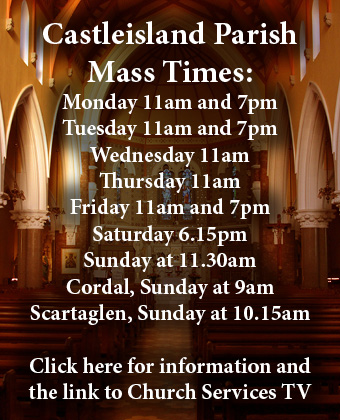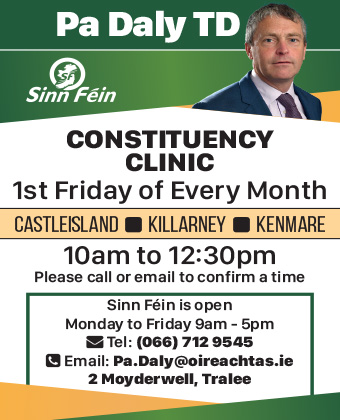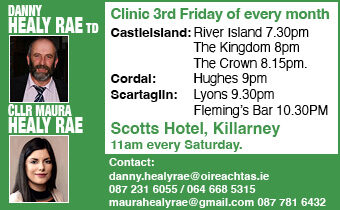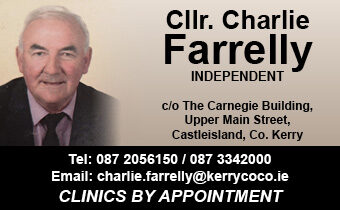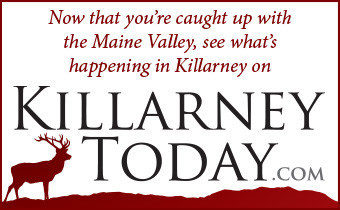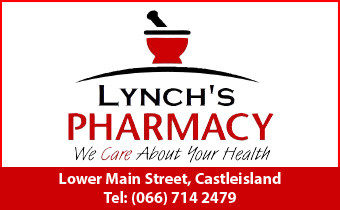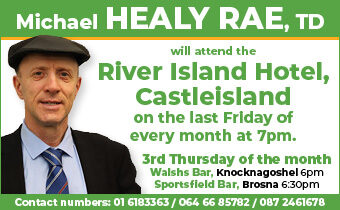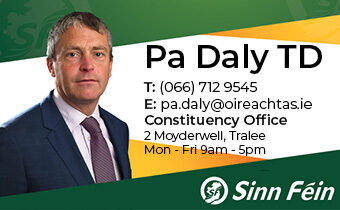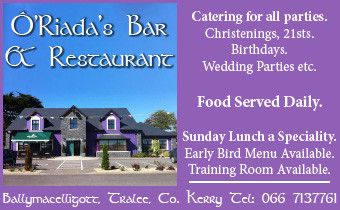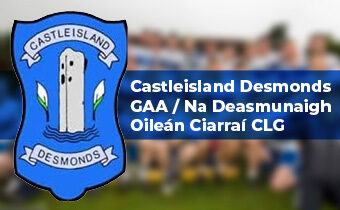


Cinema projectionist, Jamesie O’Callaghan could well have been the first man in Castleisland to impart an item of fake news – long, long before it became known as such.
One night while showing a film at The Astor Cinema and Ballroom, Jamesie had to think on his feet when the film on the reels jumped a segment of vital action.
“The Indians were after the train and they were catching up with it until it went into a long tunnell,” said Jamesie.
Then the gap in the action came into play and the danger had been averted when the film settled down again. But Jamesie had to deal with a local, regular and well known film-goer afterwards.
“That train never came out of the tunnel – what happened,” he said looking accusingly at Jamesie.
“It broke down inside in the tunnel and the Indians couldn’t figure out what happened and they went away home for themselves then,” said the projectionist as he side-stepped a scalping.
It was on the Sunday night of March 7th 1948 that the Astor Cimema hosted its first film and The Kerryman carried the first advert for the new, Killarney Road entertainment emporium.
Big News in 1948
An event like the opening of a cinema in Castleisland was big and though it didn’t get the coverage it should have in the papers in 1948, it certainly didn’t escape the research team, on one of its subsequent anniversaries, from the treasure trove that is the Divane’s Calendar collection.
The calendars, which were first published in 1994 to mark the 40th anniversary of the founding of Divane’s and its relationship with Killarney Road and well beyond, were an annual treat up to around 2012. They’re still a treasure today and they form important parts of collections in local schools and in the homes and offices of Castleislanders throughout the world.
The calendar research team was a bit of a diaspora in that you had individuals and groups of people at home and abroad beavering away separately but sharing their local knowledge on the finished product for the benefit of all.
Writing as if Possessed
I called into Sheila Prendiville’s one freezing, January evening in 2001 and there, resting an elbow on the gas heater, was Sheila and she writing away as if possessed.
Denis Divane had asked her to compile the history of her part of the street and a more enjoyable and educational evening I couldn’t have wished for. The fruits of Sheila’s labours on that memorable winter’s evening appeared on the cover of the 2002 calendar.
For the week that’s in it I thought we’d have a read of the piece on The Astor Cinema and Ballroom. This is featured on the October/November/December page of the 2006 calendar.
Make a Cup of Tea
There were great cinema-going generations here during the height of the Astor’s run from 1948 to the early 1980s.
Before I hand you over to the calendar text go away and make yourself a cup of tea or coffee or knock the cap off a bottle of whatever you like. Enjoy the trip down memory lane with the compliments of Divane’s Garage and the team involved.
The Astor
The Astor Cinema and Ballroom which opened in 1948 is, in historical terms, a relative newcomer to our town. In a social context, however, it was very well known and much loved by generations from Castleisland and beyond.
Films are popular everywhere and Castleisland is no exception. Before the building of the Astor and during the period of the silent movies and the early ‘talkies’ films were shown in Davy Griffin’s old cinema, a converted shed in Castleisland’s Latin Quarter on Killarney road.
Johnny O’Shea, the projectionist, cycled from Tralee, in hail, rain, or snow, to show the film to the waiting public. He never failed to turn up. The reels of film were encased in circular metal drums tied to the carrier of his bike. It cost the princely sum of 4d to watch the latest release. Close to the cinema, the shops of Katie Ger Jack O’Sullivan, Moll McCarthy and Maggie Leary had a tempting supply of sweets and chocolates to sustain the moviegoers.
Posters on Windows
Large posters were displayed in the windows of the cinema and were eagerly scanned to see what new films were going to be shown during the coming week. Later, weekly advertisements were carried in The Kerryman.
This was a considerable advantage to those living outside the town, as they would previously have gone to the cinema without knowing what film was showing.
However, that first cinema was not really a suitable venue, nor was it capable of dealing with the ever-increasing number of customers.
In 1948, the Coffey family, who owned the Picturedrome in Tralee, built a new cinema, The Astor, in Castleisland. The site chosen was very near the existing cinema, in an area known as Davy’s Yard, so called because Davy Griffin had originally owned it.
Local Contractor Mick Allen
Mick Allen of Killarney Road was the contractor and Pat Courtney, Barrack Street, worked on its construction. It was a very impressive building — a cinema that also served as a ballroom with a beautiful 3,000 square foot maple floor. It dominated all the other structures on Killarney Road. The advertising in the local press and the posters stressed the special lighting effects available to dancers at the Astor. On its frontage, it proudly bore the construction date and, in large letters, the legend “The World in Motion”, emblazoned around a map of the world.
Mick Allen became the manager of the cinema and he ran it together with members of his family. Michael McGillicuddy known as the ‘Ard Ri’ and Mary ‘Oggie’ O’Sullivan worked there in its early years. In later years Mrs. Norrie O’Donoghue ran a shop across the road from The Astor.
Martin Hewitt’s Take Away
Next door to the cinema, the hungry customer could tantalise his taste buds with chips and burgers from Martin Hewitt’s take away.
The Astor was the main social outlet for generations of people as it was a cinema, a ballroom and a meeting hall. The cinema opened on Sunday, March 7, 1948 and the first films shown were Prison Ship and Eve Knew her Apples. Going to ‘the pictures’ was a popular pastime. It was common to hear people say: “I’m going to the pictures to see a film.” The cinema was a window to the world for many people. It was also the main outlet for news, with Pathé News showing newsreels of current world events.
Hard Seats 8d – With Cushions 1s-3d
The hard wooden seats in the pit cost 8d, while the cushioned seats in the stalls cost 1s 3d. However, the luxury balcony, a particular favourite of many, cost 2 shillings. Many a young man faced the dilemma of either impressing his girlfriend by taking her to the balcony, or risking censure by taking her to the cheap seats. A favourite sport of those sitting in the balcony was to bombard their poor relations in the cheap seats below, with whatever missiles came to hand. Peanuts were favourite weapons.
Films were shown every night with the exception of Saturday, which was Confession Night. For the Sunday matinee, usually a cowboy film, the cinema was packed with screaming, excited youngsters cheering on their heroes. When the film ended, the story was re-enacted with great gusto all around the town by hordes of boys.
Jack Ruane and His Band
On dance nights the film ended at 10pm. There was then a major change of focus. All hands were called on deck to clear the floor of seating, set up the temporary mineral bar and prepare the Astor for the all-night dance — which ended at 3am. Frank Keane and Ned Burke were among the staff who prepared the dance floor, for which they earned 10 shillings.
The grand opening dance in the Astor Ballroom was held on Wednesday night, October 13, 1948. Jack Ruane and his band provided the music for the dance, which began at 10pm. Michael Doyle, father of the late international rugby player, Mick Doyle, provided the catering for those ‘tripping the light fantastic’ on that auspicious occasion.
The first Rugby Club dance held at the Astor was on November 21, 1948. The admission charge was 8/6 with ‘optional dress code’ and music by Pat Crowley and his Ballroom Orchestra.
Banned During Lent
Dances were banned during Lent. On Sunday nights during Lent, when dances would otherwise be held, young people flocked to the cinema. Many failed to get a seat such was the demand. One man flouted the dancing ban. The well-known matchmaker Dan Paddy Andy, ran his own dances in Lyreacrompane during Lent, incurring the wrath of local priests, but this mattered little as he was constantly at loggerheads with the clergy anyway.
In the 1950s supper dances were in vogue; later socials became popular. They were all held in The Astor with catering by local shop-keeper Tommy O’Rourke and were well attended. They were generally organised by various clubs and associations such as the local Fianna Fáil and Fine Gael Cumainn, The Ploughing Match Association, The Rugby Club and others. The Astor was also hired out for other purposes ranging from club meetings to basketball.
First Blitz in the Astor in 1970
The first Basketball Blitz in Castleisland was played there in 1970.
During the Dancehall Era, from the late 1950s, people travelled from miles around, to trip the light fantastic, to the sounds of local man Paddy Breen and the Island Swing Band. Mick Delahunty and his band were regular visitors. The bands of Jimmy Rohan and Denis Cronin from Tralee and the bands of Pat Crowley and Stephen Garvey were amongst the earliest performers of that era who delighted the dancing public in The Astor.
’80s Roller Disco Craze
In 1970 Jimmy O’Connor, a teacher from Ballymacelligott, bought The Astor. Under his ownership it became very popular as a dance venue. In later years it hosted discos and it was thronged every Sunday during the roller disco craze of the 1980s.
Like cinemas in rural towns all over Ireland, progress decided the future of The Astor. With the introduction of the video player and the nightclub, it became a victim of changing taste and fashion, and closed in 1985.
Today the building is owned by the Conroy family and is a leading furniture shop which, in this year of Our Lord 2024, is for sale.
 You can contact The Maine Valley Post on… Anyone in The Maine Valley Post catchment area who would like to send us news and captioned photographs for inclusion can send them to: jreidy@mainevalleypost.com Queries about advertising and any other matters regarding The Maine Valley Post can also be sent to that address or just ring: 087 23 59 467.
You can contact The Maine Valley Post on… Anyone in The Maine Valley Post catchment area who would like to send us news and captioned photographs for inclusion can send them to: jreidy@mainevalleypost.com Queries about advertising and any other matters regarding The Maine Valley Post can also be sent to that address or just ring: 087 23 59 467.



